2008 MERCEDES-BENZ SL ROADSTER wheel
[x] Cancel search: wheelPage 56 of 317
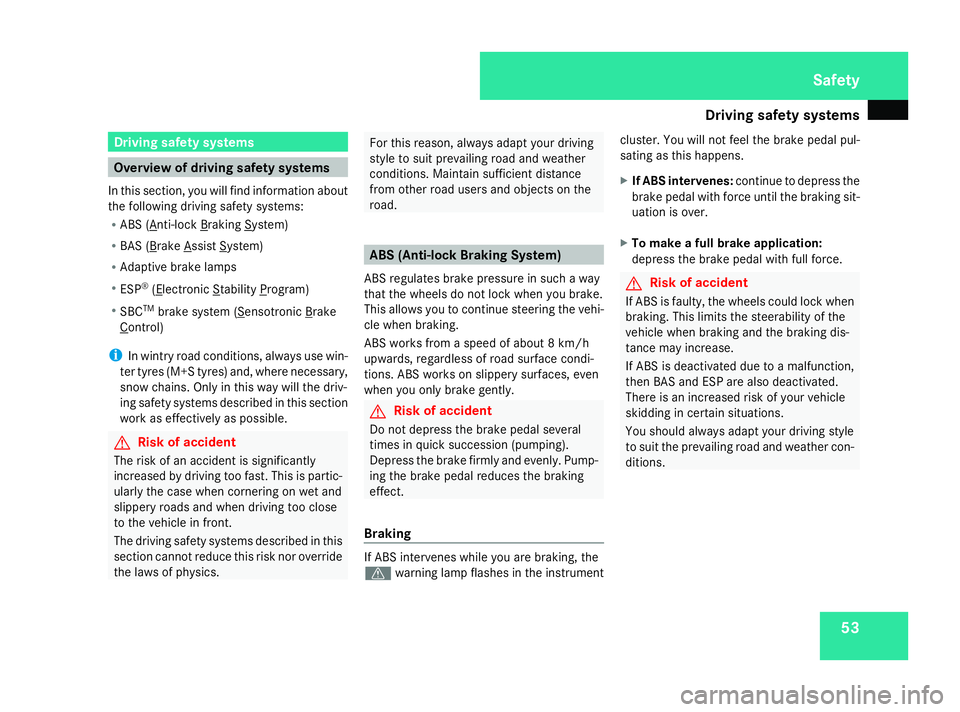
Driving safet
ysystems 53Driving safety systems
Overvie
wofdrivingsafety systems
In thi ssection, yo uwillf in di nformation about
the following driving safety systems:
R ABS ( Anti-lock Braking System)
R BAS ( Brake Assist System)
R Adaptive brake lamps
R ESP ®
( Electronic Stability Program)
R SBC TM
brake syste m( Sensotronic Brake
Control)
i In wintry roa dconditions ,alway susewin-
ter tyres (M+ Styres )and ,w here necessary,
sno wchains .Onlyint hisw aywill the driv-
ing safety systems describe dinthiss ection
work as effectivel yaspossible. G
Ris
kofa ccident
Th er iskofana ccident is significantly
increase dbydriving too fast. This is partic-
ularly the case when cornering on we tand
slippery roads and when driving too close
to the vehicl einfront.
Th ed riving safety systems describe dinthis
sectio ncannot reduc ethisr iskn or override
the laws of physics. For thi
sreason, always adap tyou rd riving
style to suit prevailing roa dand weather
conditions .Maintain sufficient distance
fro mo ther roa dusers and objects on the
road. ABS (Anti-lock Braking System)
ABS regulate sbrake pressure in such away
tha tthe wheels do not lock when yo ubrake.
This allows yo utocontinue steering the vehi-
cle when braking.
ABS works fro maspeed of abou t8km/h
upwards ,regardles sofroads urface condi-
tions. ABS works on slippery surfaces ,even
when yo uonlyb rake gently. G
Ris
kofa ccident
Do not depress the brake peda lsev eral
times in quick succession (pumping).
Depres sthe brake firml yand evenly .Pum p-
ing the brake peda lreduces the braking
effect.
Braking If ABS intervenes whil
eyou areb raking ,the
v warning lamp flashe sinthe instrument cluster. Yo
uwilln ot fee lthe brake peda lpul-
sating as thi shappe ns.
X If ABS intervenes: continue to depress the
brake peda lwithf orce unti lthe braking sit-
uatio niso ver.
X To make afullb rak eapplication:
depress the brake peda lwithf ullf orce. G
Ris
kofa ccident
If ABS is faulty, the wheels could lock when
braking .Thisl imit sthe steerability of the
vehicl ewhenb raking and the braking dis-
tanc emayincrease.
If ABS is deactivate dduetoam alfunction,
the nB AS and ESP ar ealsod eact ivated.
There is an increase driskofy ourv ehicle
skidding in certai nsituations.
Yo us houl dalway sadapt your driving style
to suit the prevailing roa dand weather con-
ditions. Safety
230_AKB; 5; 4, en-GB
bjanott,
Version: 2.9.6 2008-04-08T15:09:54+02:00-Seite 53 ZDateiname: 6515_3089_02_buchblock.pdf; preflight
Page 57 of 317
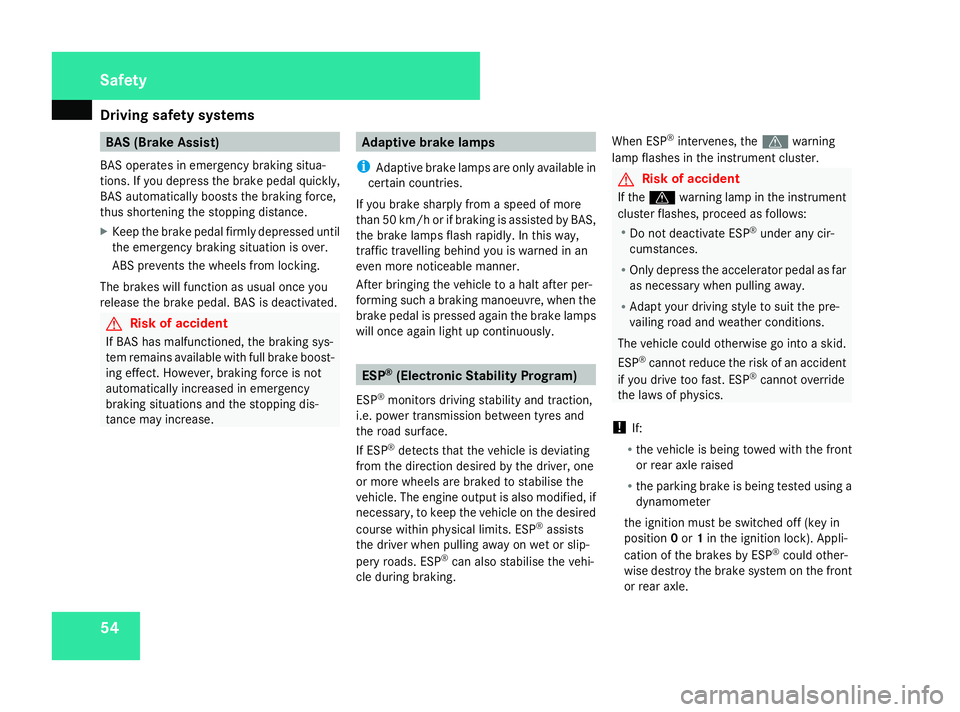
Driving safet
ysystems 54 BAS (Brake Assist)
BAS operates in emergency braking situa-
tions. If yo udepress the brake peda lquickly,
BAS automaticall yboost sthe braking force,
thu sshortening the stopping distance.
X Kee pthe brake peda lfirml yd epresse duntil
the emergency braking situatio niso ver.
ABS prevents the wheels fro mlocking.
Th eb rakes will functio nasusual once you
release the brake pedal. BAS is deactivated. G
Ris
kofa ccident
If BAS ha smalfu nctioned ,the braking sys-
tem remains availabl ewithf ullb rake boost-
ing effect. However, braking force is not
automaticall yincrease dinemergency
braking situations and the stopping dis-
tanc emayincrease. Adaptive brak
elamps
i Adaptive brake lamps ar eonlya vailable in
certai ncountries.
If yo ubrake sharpl yfromas peed of more
tha n50k m/h or if braking is assiste dbyBAS,
the brake lamps flas hrapidly .Inthisw ay,
traffi ctravelling behind yo uiswarne dinan
eve nm oren oticeabl emanner.
After bringing the vehicl etoahalta fter per-
forming such abraking manoeuvre, when the
brake peda lispresse dagain the brake lamps
will once agai nlight up continuously. ESP
®
(Electroni cStability Program)
ESP ®
monitors driving stability and traction,
i.e .p ower transmission between tyres and
the roa dsurface.
If ESP ®
detects tha tthe vehicl eisdeviating
fro mt he directio ndesir ed by the driver ,one
or mor ewheel sarebraked to stabilise the
vehicle. Th eengine outpu tisa lsom odified, if
necessary ,tokeept he vehicl eonthe desired
course withi nphysical limits. ESP ®
assists
the driver when pulling away on we torslip-
pery roads .ESP ®
ca na lsos tabilise the vehi-
cle during braking. When ESP
®
intervenes ,the v warning
lamp flashe sinthe instrumen tcluster. G
Ris
kofa ccident
If the v warning lamp in the instrument
cluste rflashes ,procee dasfollows:
R Do not deactivate ESP ®
under any cir-
cumstances.
R Onl ydepress the accelerator peda lasfar
as necessary when pulling away.
R Adapt your driving style to suit the pre-
vailing roa dand weather conditions.
Th ev ehicl ecould otherwis egointoaskid.
ESP ®
cannot reduc ethe risk of an accident
if yo udrive too fast. ESP ®
cannot override
the laws of physics.
! If:
R the vehicl eisbeing towed with the front
or rea raxler aised
R the parking brake is being tested using a
dynamometer
the ignition must be switched off (ke yin
position 0or 1in the ignition lock). Appli-
catio noft he brakes by ESP ®
could other-
wise destro ythe brake syste monthe front
or rea raxle. Safety
230_AKB; 5; 4, en-GB
bjanott,
Version: 2.9.6 2008-04-08T15:09:54+02:00-Seite 54 Dateiname: 6515_3089_02_buchblock.pdf; preflight
Page 58 of 317
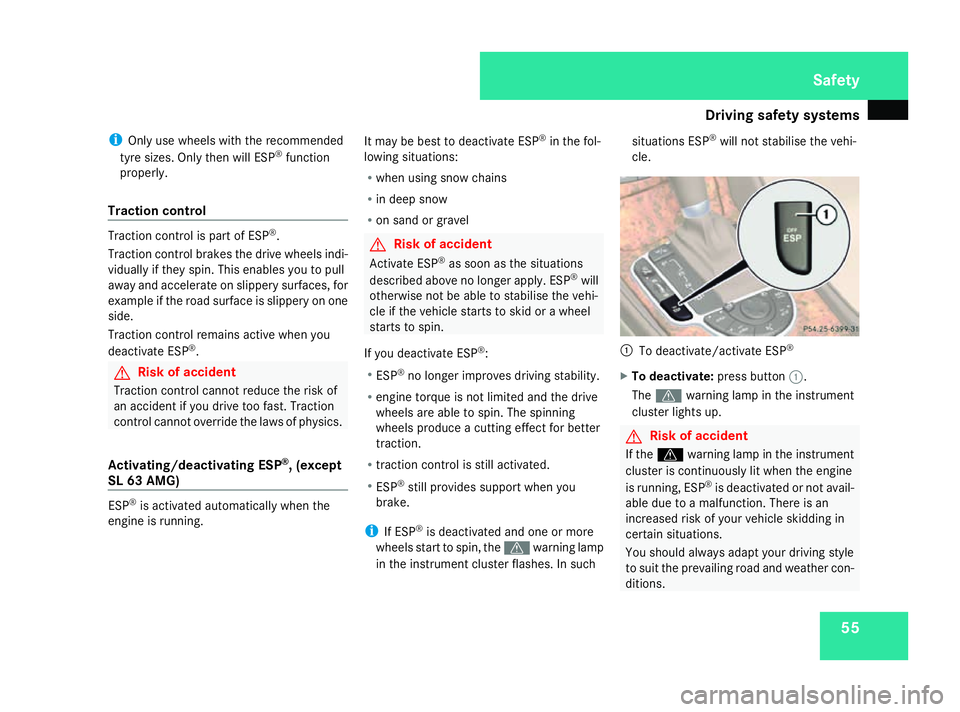
Driving safet
ysystems 55
i
Onlyusewheels with the recommended
tyr es izes .O nlyt henw illE SP ®
function
properly.
Tractio ncontrol Tractio
ncontrol is part of ESP ®
.
Tractio ncontrol brakes the drive wheels indi-
vidually if the yspin. This enables yo utopull
away and accelerate on slippery surfaces ,for
exampl eifthe roa dsurface is slippery on one
side.
Tractio ncontrol remains activ ewheny ou
deactivate ESP ®
. G
Ris
kofa ccident
Tractio ncontrol cannot reduc ethe risk of
an accident if yo udrive too fast. Traction
control cannot override the laws of physics.
Activating/deactivating ESP ®
,( exce pt
SL 63 AMG) ESP
®
is activate dautomaticall ywhent he
engine is running. It ma
ybeb esttod eactivate ESP ®
in the fol-
lowing situations:
R when using sno wchains
R in deep snow
R on sand or gravel G
Ris
kofa ccident
Activate ESP ®
as soon as the situations
describe dabove no longe rapply .ESP ®
will
otherwis enot be able to stabilise the vehi-
cle if the vehicl estarts to ski dorawheel
starts to spin.
If yo udeact ivate ESP ®
:
R ESP ®
no longe rimp roves driving stability.
R engine torque is not limited and the drive
wheels ar eabletos pin. Th espinning
wheels produce acutting effect for better
traction.
R tractio ncontrol is still activated.
R ESP ®
still provide ssuppo rt when you
brake.
i If ESP ®
is deactivate dand one or more
wheels start to spin, the vwarning lamp
in the instrumen tcluste rflashes .Insuch situations ESP
®
will not stabilise the vehi-
cle. 1
To deactivate/activate ESP ®
X To deactivate: press button1.
The v warning lamp in the instrument
cluste rlight sup. G
Ris
kofa ccident
If the v warning lamp in the instrument
cluste riscontinuously li twhent he engine
is running ,ESP ®
is deactivate dornot avail-
able du etoam alfunction. There is an
increase driskofy ourv ehicl eskidding in
certai nsituations.
Yo us houl dalway sadapt your driving style
to suit the prevailing roa dand weather con-
ditions. Safety
230_AKB; 5; 4, en-GB
bjanott,
Version: 2.9.6 2008-04-08T15:09:54+02:00-Seite 55 ZDateiname: 6515_3089_02_buchblock.pdf; preflight
Page 59 of 317

Driving safet
ysystems 56
X
To activate: press button 1.
The v warning lamp in the instrument
cluste rgoeso ut.
SL 63 AMG Activating/deactivating ESP
®
Sport
ESP ®
is activate dautomaticall ywhent he
engine is running.
It ma ybeb esttoa ctivate ESP ®
Sport in the
following situations:
R when using sno wchains
R in deep snow
R on sand or gravel
Otherwise, yo ushoul donlyu seESP ®
Sport
on designated race circuits. G
Ris
kofa ccident
Deactivate ESP ®
Sport and activate ESP ®
as soon as the situations describe dabove
no longe rapply .ESP ®
Sport will otherwise
onl ybea bletos tabilise the vehicl etoa
limited degre eifthe vehicl estarts to skid
or aw heel starts to spin. If yo
uactivate ESP ®
Sport:
R ESP ®
onl yimp roves driving stability to a
limited degree.
R engine torque is onl yrestricted to alimit ed
degre eand the drive wheels ar eableto
spin. Th espinning wheels produce acut-
ting effect for better traction.
R tractio ncontrol is still activated.
R ESP ®
still provide ssuppo rt when yo ubrake
firmly.
i If ESP ®
Sport is activate dand one or more
wheels start to spin, the vwarning lamp
in the instrumen tcluste rflashes .ESP ®
only
stabilise sthe vehicl etoalimited degree. 1
Activating/deactivating ESP ®
Sport X
To activate: brieflypress button 1.
The v warning lamp in the instrument
cluste rlight sup.Them essage ESP Sport
appear sinthe multi-functio ndisplay.
X To deactivate: brieflypress button 1.
The v warning lamp in the instrument
cluste rgoeso ut.T he message ESP On
appear sinthe multi-functio ndisplay.
To deactivate/activate ESP ®
ESP ®
is activate dautomaticall ywhent he
engine is running.
It ma ybeb esttod eactivate ESP ®
in the fol-
lowing situations:
R when using sno wchains
R in deep snow
R on sand or gravel G
Ris
kofa ccident
Activate ESP ®
as soon as the situations
describe dabove no longe rapply .ESP ®
will
otherwis enot be able to stabilise the vehi-
cle if the vehicl estarts to ski dorawheel
starts to spin. Safety
230_AKB; 5; 4, en-GB
bjanott,
Version: 2.9.6 2008-04-08T15:09:54+02:00-Seite 56 Dateiname: 6515_3089_02_buchblock.pdf; preflight
Page 60 of 317
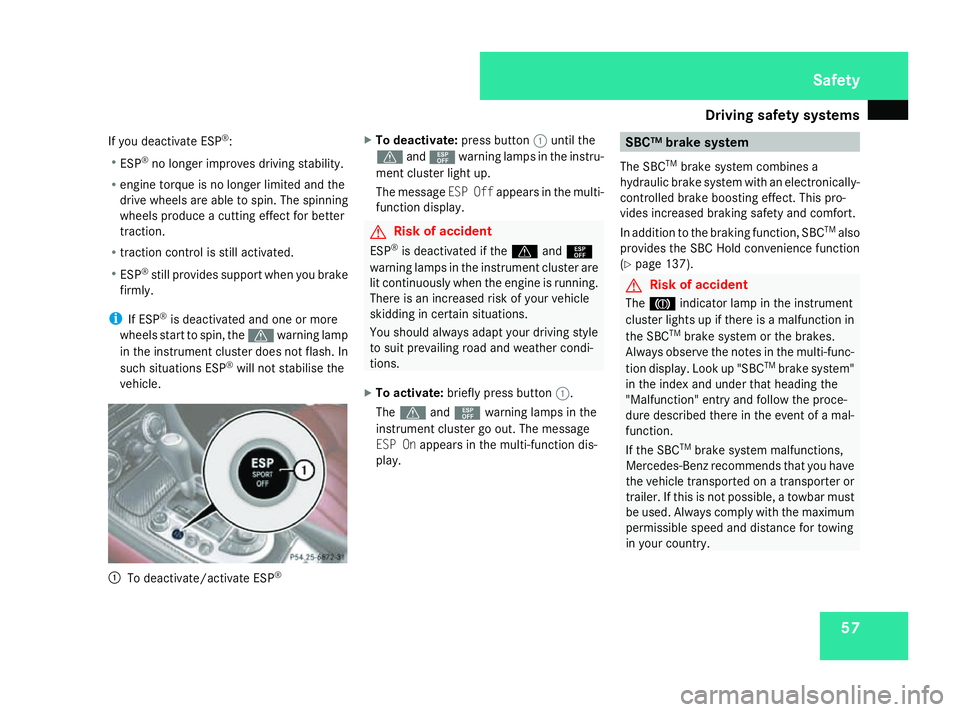
Driving safet
ysystems 57
If yo
udeact ivate ESP ®
:
R ESP ®
no longe rimp roves driving stability.
R engine torque is no longe rlimit ed and the
drive wheels ar eabletos pin. Th espinning
wheels produce acutting effect for better
traction.
R tractio ncontrol is still activated.
R ESP ®
still provide ssuppo rt when yo ubrake
firmly.
i If ESP ®
is deactivate dand one or more
wheels start to spin, the vwarning lamp
in the instrumen tcluste rdoesn ot flash. In
such situations ESP ®
will not stabilise the
vehicle. 1
To deactivate/activat eESP® X
To deactivate: pressbutton 1untilt he
v and¯ warning lamp sinthe instr u-
ment cl usterlight up.
Th em essage ESPO ffappear sinthe multi-
function displa y. G
Risk of ac
cident
ESP ®
is deactivated if the vand¯
warning lamp sinthe instr umentclus tera re
li tc ontin uously when the engin eisrunning.
Ther eisani ncreased risk of yourvehicle
skiddin gincertain situations.
Yo us hould alwaysadap tyou rd riving style
to suit prevailing road an dweather condi-
tions.
X To activate: brieflypress button 1.
The v and¯ warning lamp sinthe
instr ument clus tergoo ut.T he message
ES POn appear sinthe multi-function dis-
play. SBC
™brake system
Th eS BCTM
brak esystemc ombines a
hydrauli cbrake syste mwithane lectronicall y-
controlled brak eboost inge ffec t. This pro-
vide sincreased brakin gsafet yand comfort.
In additio ntothe brakin gfun ction, SBC TM
also
provides the SBC Hold convenienc efunction
(Y page 137). G
Risk of ac
cident
The 3 indicator lamp in the instr ument
cl us terlight supift here isamalfun ction in
the SBC TM
brak esystemort he brakes.
Alwa ysobserve the note sinthe multi-func-
tio nd isplay. Lookup"SBC TM
brak esystem"
in the inde xand un dertha th eading the
"Malfunction" entry an dfollow the proce-
dure described there in the event of amal-
function.
If the SBC TM
brak esystemm alfun ctions,
Mercedes-Benz recommends tha tyou have
the vehicl etransported on atransporter or
trailer .Ifthisisn ot possible ,atowba rmust
be used. Alwayscompl ywitht he maxim um
permissible spee dand distance fo rtowing
in your country. Safety
230_AKB; 5; 4, en-GB
bjanott,
Version: 2.9.6
2008-04-08T15:09:54+02:00
-Seite 57 ZDateiname: 6515_3089_02_buchblock.pdf; preflight
Page 66 of 317
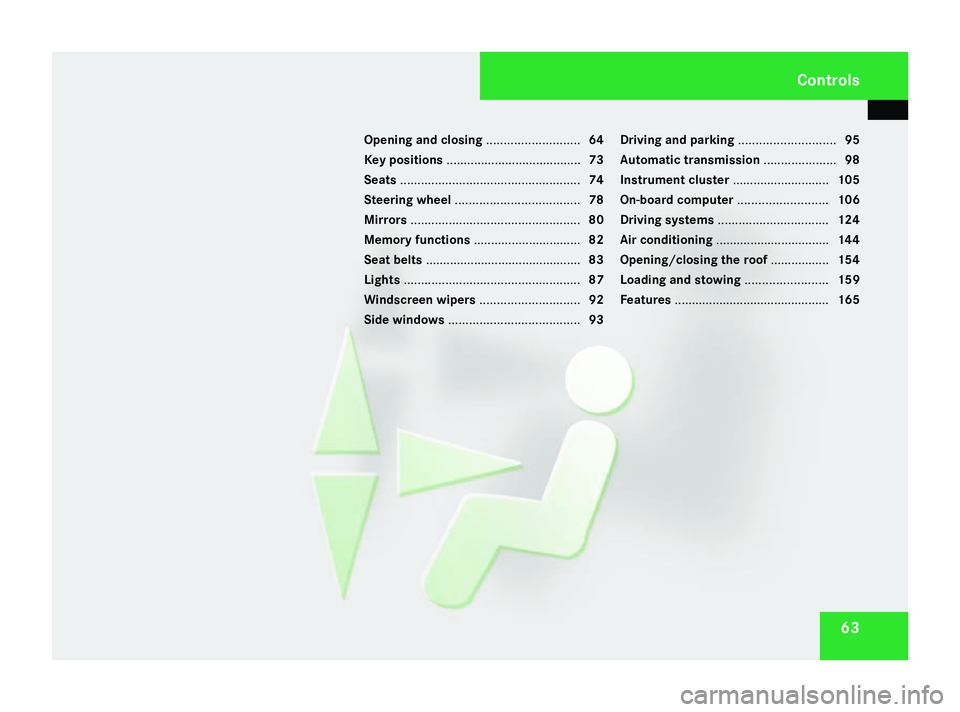
63
Opening and closing
...........................64
Key positions ....................................... 73
Seats .................................................... 74
Steering wheel .................................... 78
Mirrors ................................................. 80
Memor yfunctions ............................... 82
Seat belts ............................................. 83
Lights ................................................... 87
Windscreen wipers .............................92
Side windows ...................................... 93Driving and parking
............................95
Automatic transmission .....................98
Instrument cluster ............................105
On-boar dcomputer .......................... 106
Driving systems ................................ 124
Air conditioning ................................. 144
Opening/closing the roof .................154
Loading and stowing ........................159
Features ............................................. 165 Controls
230_AKB
;5;4,en-GB
bjanott, Version:2.9.6
2008-04-08T15:09:54+02:0
0-Seite 63 Dateiname: 6515_3089_02_buchblock.pdf; preflight
Page 71 of 317
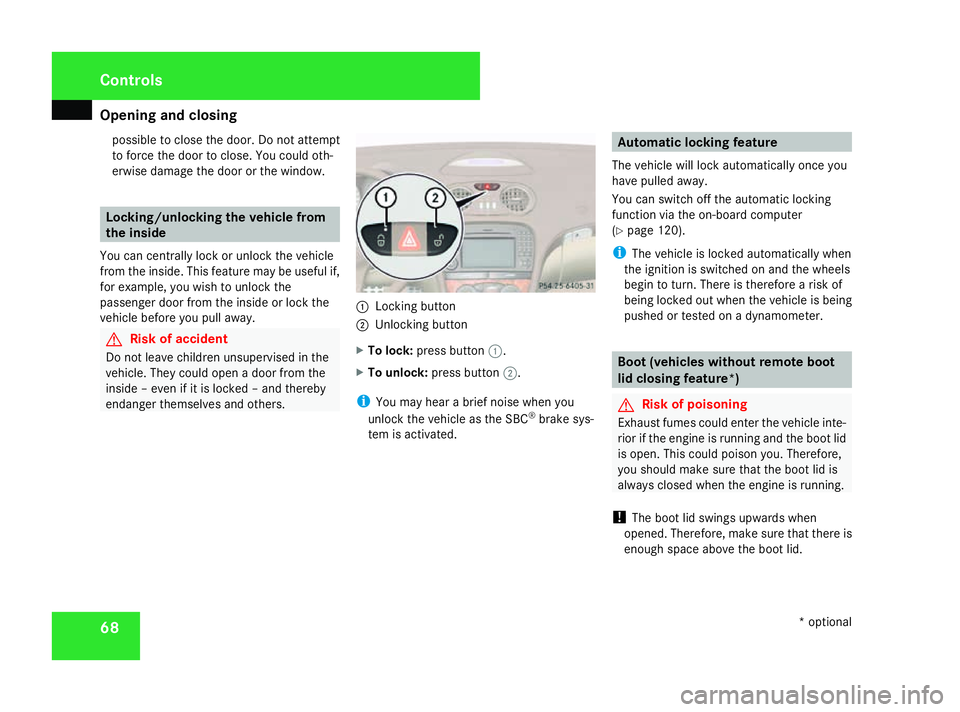
Opening and closing
68possible to close the door. Do not attempt
to forc
ethe door to close. You could oth-
erwise damage the door or the window. Locking/unlocking the vehicle from
the inside
You can centrally lock or unlock the vehicle
from the inside. This feature may be useful if,
for example, you wish to unlock the
passenger door from the inside or lock the
vehicle before you pull away. G
Risk of accident
Do not leave children unsupervised in the
vehicle. They could open adoor from the
inside –even if it is locked –and thereby
endanger themselves and others. 1
Lockingb utton
2 Unlocking button
X To lock: press button 1.
X To unlock: press button 2.
i You may hear abrief noise when you
unlock the vehicle as the SBC ®
brake sys-
tem is activated. Automatic lockingf
eature
The vehicle will lock automatically once you
have pulleda way.
You can switch off the automatic locking
function via the on-board computer
(Y page 120).
i The vehicle is locked automatically when
the ignition is switched on and the wheels
begin to turn. There is therefore arisk of
being locked out when the vehicle is being
pushed or tested on adynamometer. Boot (vehicles without remote boot
lid closing feature*)
G
Risk of poisoning
Exhaust fumes could enter the vehicle inte-
rior if the engine is running and the boot lid
is open. This could poison you. Therefore,
you should make sure that the boot lid is
always closed when the engine is running.
! The boot lid swings upwards when
opened. Therefore, make sure that there is
enough space above the boot lid. Controls
*optional
230_AKB; 5; 4, en-GB
bjanott
,V ersion: 2.9.6
2008-04-08T15:09:54+02:00
-Seite 68 Dateiname: 6515_3089_02_buchblock.pdf; preflight
Page 78 of 317
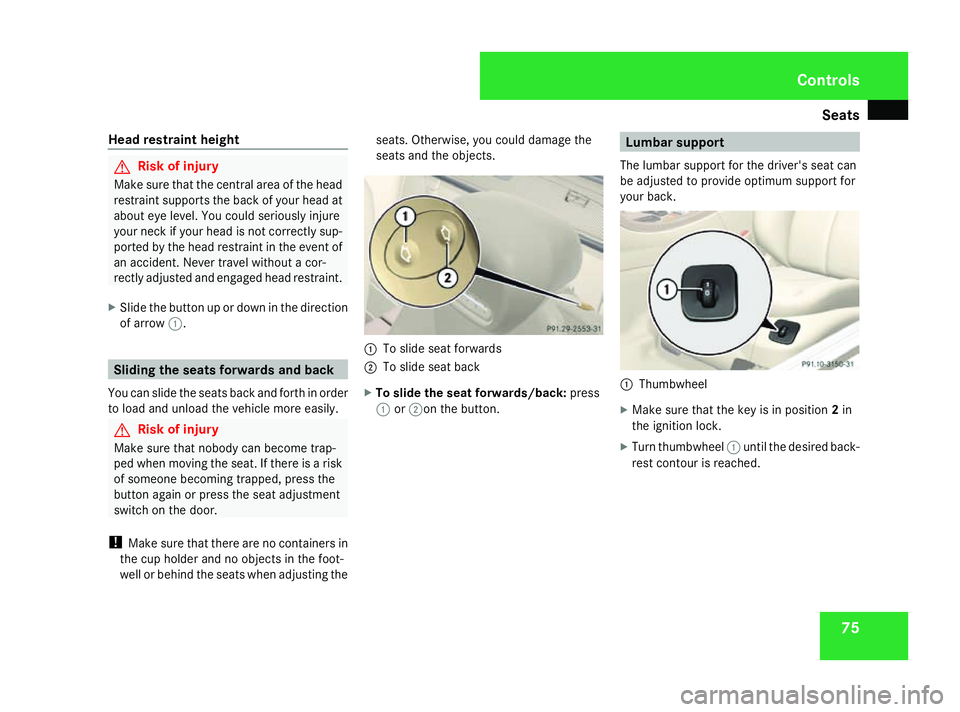
Seats
75
Head restraint height G
Risk of injury
Make sure that the central area of the head
restraint supports the back of your head at
about eye level. You could seriously injure
your neck if your head is not correctly sup-
ported by the head restraint in the event of
an accident. Never travel without acor-
rectly adjusted and engaged head restraint.
X Slide the button up or down in the direction
of arrow 1. Sliding the seats forwardsa
nd back
You can slide the seats back and forth in order
to load and unload the vehicle more easily. G
Risk of injury
Make sure that nobody can become trap-
ped when moving the seat. If there is arisk
of someone becoming trapped, press the
button again or press the seat adjustment
switch on the door.
! Make sure that there are no containers in
the cup holder and no objectsint he foot-
well or behind the seats when adjusting the seats. Otherwise, you could damage the
seats and the objects.
1
To slide seat forwards
2 To slide seat back
X To slide the seat forwards/back: press
1 or2on the button. Lumbar support
The lumbar support for the driver's seat can
be adjusted to provide optimum support for
your back. 1
Thumbwheel
X Make sure that the key is in position 2in
the ignition lock.
X Turn thumbwheel 1until the desired back-
rest contour is reached. Controls
230_AKB; 5; 4, en-GB
bjanott
,V ersion: 2.9.6
2008-04-08T15:09:54+02:00
-Seite 75 ZDateiname: 6515_3089_02_buchblock.pdf; preflight